
For GREAT deals on a new or used Jaguar check out Jaguar Cincinnati TODAY!
Richard Hammond, as you may be aware, is not merely a renowned TV presenter, he’s likewise the proprietor of a classic car service center called The Smallest Cog. He might likewise soon be the proprietor of an auto racing group referred to as Team Smallest Cog.
That is the revelation from the latest video on DriveTribe, in which Hammond offers viewers an excursion of his personal lorry storage space barn. A humbly decorated warehouse, albeit one with plenty in it, The Grand Tour host runs through his collection of cars and also his plans for them.
At the end of the video, he discusses his “truly huge strategies” for a blue 1972 MGB GT. Not only that, but he also clarifies just how he came to have the auto, which was obviously implied to show up on one of his really last episodes as host of Top Gear.
Read: You Could Own The Top Gear TVR Sagaris For Less Than A Porsche Cayman GTS
“It is the last cars and truck I drove on the top Gear. Prior to everything transformed,” he discusses. “I drove it due to the fact that we did a thing, and also we stated let’s address vintage cars– the other two do not actually like classic automobiles, I do– I purchased this since I believed, well, it’s the archetypal every male standard.”
Hammond admits, however, that he had never ever driven one before obtaining this really auto for the manufacturing. He says that he could not think how good the auto was, in spite of not being a specifically unusual neither pricey classic.
“I assumed it was one of the most amazing little automobile. It’s got a feeling of completeness to it,” he claims. “Actually it’s a crisp, wonderful magnificently well balanced, Pininfarina-styled, charming little British sports car as well as I have a plan for it. A large strategy.”
He clarifies, the cars and truck will be a way to market his garage to enthusiastic proprietors that desire their classics repaired. And also there is no person more enthusiastic, neither a lot more in requirement of fixings, than individuals who go classic car racing.
“So I am mosting likely to take that auto racing as Team Smallest Cog, and we are mosting likely to race together with individuals with other vintage cars, and they are going to learn to understand us,” Hammond says. “And when we watch them smear their auto down a wall as well as into the tires, we’ll be competing alongside them. I will give them a business card, and hopefully they’ll give the vehicle to us to correct.”
For GREAT deals on a new or used Land Rover check out Envision Land Rover TODAY!
Featured on AutoHunter, the on-line auction system driven by ClassicCars.com, is this 1966 Chevrolet Impala.
This 1966 Impala was redecorated in metallic red with a metal silver roof covering. The metal red exterior is matched by an aluminum grille, chrome bumpers, and also unabridged bodyside trim. It flights on a collection of chrome reversed 14 ″ x 7 ″ U.S. Wheel Supreme wheels with chrome center cap and also Remington whitewall tires.
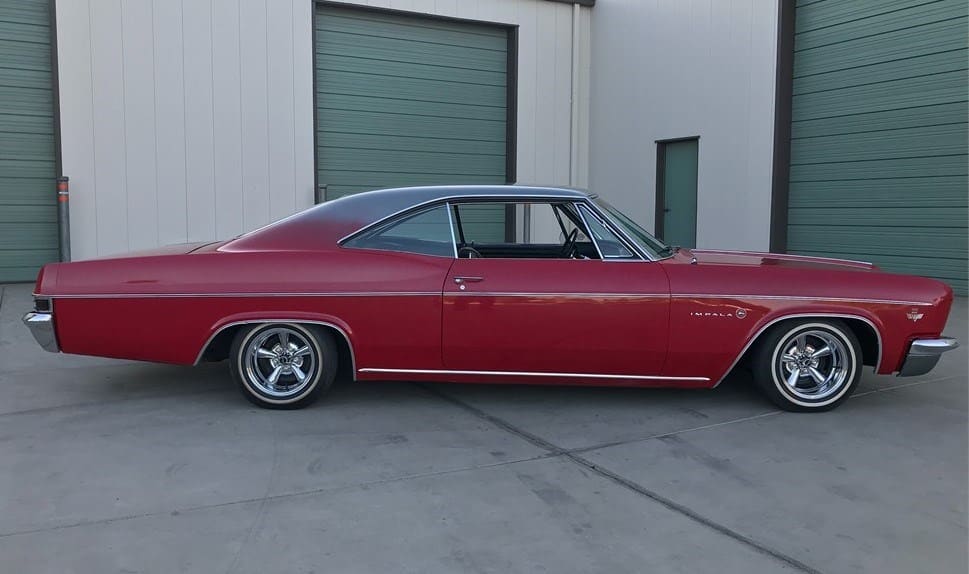
Under the hood is 350ci V8 engine featuring an Edelbrock four-barrel carburetor with an electric choke, an HEI representative, and also tube exhaust headers. The engine is spruced up with chrome valve covers, a chrome air cleaner cover, and a light weight aluminum radiator maintains every little thing cool.
The engine is paired with a floor-shifted TH350 transmission.
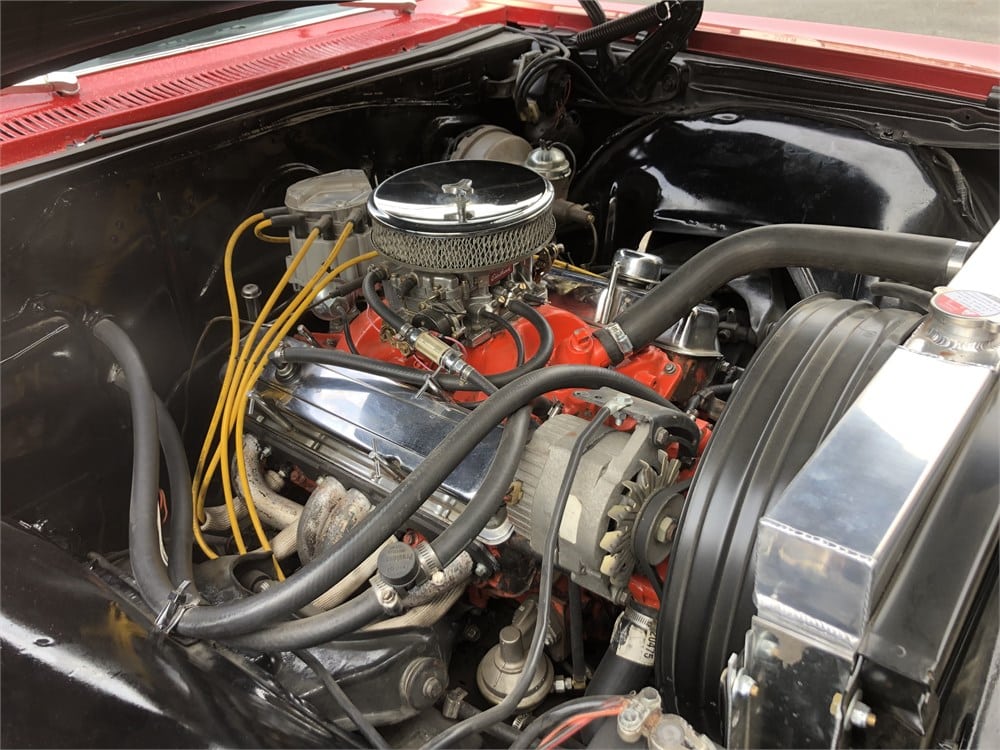
This 1966 Chevrolet Impala’s auction ends on Friday, October 28, 2022, at 11:00 a.m. (PDT)
Visit the AutoHunter listing for more information and also photo gallery.
For GREAT deals on a new or used Infiniti check out Infiniti of Valencia TODAY!
tried– and also frantically stopped working– to capture the attention of the American fan.
CC Off English This blog is part of a collection on Formula 1’s existence in America. The sporting activity has actually had a fabled– but not specifically successful– history in the country.
As F1 grows in America, and as we approach the 2022 United States Grand Prix, Jalopnik is taking a look back at the places left in the dirt as well as what ultimately brought about their desertion. You could, probably, forgive F1’s hubris when it involved road races because it had managed to assemble an extremely effective occasion in Long Beach that really ought to not have functioned. Chris Pook, a previous travel representative transformed race marketer, saw possibility for a Monaco Grand Prix-style occasion in America and established his views on the community of Long Beach, California many thanks to its closeness to Los Angeles.
Advertisement Pook’s strategy actually shouldn’t have actually worked. In the late 1970s, Long Beach was a relatively dismaying commercial port city that was quickly swept up in a corruption rumor and would need over $100 million in redevelopment to prepare it to host a worldwide occasion, Randall Cannon creates in Caesars Palace Grand Prix. Much of that cash mosted likely to the remediation of the Queen Mary, but in 1975, Pook was lastly granted his Long Beach Grand Prix.
The FIA-sanctioned event for 1976 was previewed by a 1975 Formula 5000 race. At the time, Formula 5000 was hugely prominent among American open-wheel vehicle drivers, and also even international abilities like James Hunt, Jody Scheckter, as well as David Hobbs would travel Stateside to compete along with the similarity Mario Andretti, Al and also Bobby Unser, as well as Sam Posey.
Advertisement
Not everybody was pleased. From Caesars Palace Grand Prix:
Pre-race press additionally kept in mind the participation of the Long Beach General fund in the motorsports promotion. “Long Beach city authorities accepted progress $400,000 that was already set up in the master plan,” reported the Los Angeles Times, “as well as to pay an additional $101,500 for special enhancing, sidewalk, aesthetics, as well as safety and security barriers that will be paid back by the race promoters.” In the middle of the government examination and also boosted examination at City Hall, the general public financial investment in the otherwise private for-profit promotion would certainly come to be a flashpoint. “The city is being paid of amazing costs, such as added cops,” was the terminology offered to the public.”
The Los Angeles Times likewise promoted the financial investment and funding of the Long Beach Grand Prix Association itself. Building on a $40,000 start-up financial investment by Chris Pook and also his companions, “additional financing is being organized with a special intrastate public offering to raise from $950,000 to $1,575,000 for operational and organizational costs.”
Advertisement With the funds inevitably earned, the Formula 5000 race at Long Beach was set to run. Chauffeurs lauded the special precaution and also the intestines it took to in fact host an occasion in the center of a city– particularly taking into consideration the circuit felt refreshingly modern when compared to the ailing Watkins Glen International.
The finances weren’t quite as promising. Pook confessed that he had overestimated the number of people who would certainly purchase a ticket to the occasion, and the initial Long Beach race reported a loss of $300,000.
Advertisement Things additionally declined heading into the track’s 1976 event. The obstacles seemed to have actually blocked some track surface area, as well as the asphalt was crumbling. At the end of the event, it appeared that Pook had actually once again overstated attendance figures, with monetary records showing yet one more huge loss. The 1977 race occurred despite Pook as well as various other organizers owing $150,000 to FOCA, a union composed of British teams.
After its preliminary growing pains, though, Long Beach ended up being understood for its interesting races, and also it tackled a substantial degree of value after Watkins Glen lost its race day ahead of the 1981 season. There was still an issue, though: As reported in the Indy Star, Pook was basically putting together a$ 6 million event in the hopes of making$100,000. That was largely due to the massive fees F1 billed an occasion place just to appear at its location. For the 1984 season, Pook
chose to toss F1 to the visual and enable Long Beach to come to be a best occasion for CART, a progenitor of the modern-day IndyCar series. Advertisement Pook’s choice highlighted a substantial trouble that was expanding in F1: The sport was just as well damn pricey, and also the needs it levied on its tracks were unreasonable. Successful tracks in America didn’t require to invest millions to attract F1 in order to organize a successful racing event; they might make a profit by drawing in smaller sized crowds for a CART event.
Because of this, F1’s choices for race venues in America ended up being … rather strange. First came the chaos of F1’s very first journeys to Las Vegas, where it took over 75 acres of Caesars Palace’s parking lot to host a race. (Compare that to, state, the 1,000 acres offered at Watkins Glen, and also you’ll begin to obtain a concept of the scale here.) The track was vast enough to help with some overtaking, however the mid-day races as well as the pressures of a counter-clockwise circuit made the track among the most tough on the schedule.
Advertisement Once again, pressures aligned in such a way that extremely few people showed up to either race, resulting in substantial economic losses to Caesars Palace, Cannon creates in Caesars Palace Grand Prix. After the 1982 Grand Prix event, Caesars Palace hosted two years of CART before quiting on the prospect of changing a parking lot into a race course.
Also before the desire at Caesars Palace absolutely passed away, however, Chris Pook was already trying to develop an additional grip in America. The 1982 F1 season made history for being the very first year that included 3 races in the exact same nation many thanks to the June enhancement of the Detroit Grand Prix together with Caesars Palace as well as Long Beach.
Advertisement The race ran for 5 years, yet part of Detroit’s rate of interest in case was refurbishing the image of the once-great Motor City, as well as the decrease of the city displayed in a harsh track surface area susceptible to falling apart that also originally consisted of a railroad going across.
Issues were evident from the start. The 1982 Detroit Grand Prix was expected to start with a Thursday practice session, yet it was cancelled, as well as Friday’s certifying had to be held off because of organizational concerns. As the years passed, even changes to the track format fell short to stop high degrees of attrition, as well as the mid-summer timing usually resulted in uncertain weather. When the last race was presented in 1988, it was so disgustingly warm and also moist that the drivers had a hard time in the cockpit. Worse, the weather resulted in extra substantial track degeneration. Paired with a routine loss of cash when it came to organizing the event, Detroit’s fate was secured.
Advertisement Formula 1 considered relocating the track to Belle Isle, a park near Detroit’s downtown, yet the collection was ready to hang up its American hat in the Motor City. Rather, CART took over the Belle Isle track, as well as IndyCar has actually competed there ever since. Throughout Detroit’s run came yet one more American venue, this moment in Dallas ‘Fair Park for 1984. I’ll simply let a quote from Randall Cannon’s Caesars Palace Grand Prix established the appropriate tone: Bill Weinberger of Caesars Palace as well as marketer Jack Long would be involved in both races [in Las Vegas and Dallas] “[ The] Detroit race was perhaps,” remembered Weinberger, “the greatest clusterfuck in which I have ever been involved.”
Advertisement
In Dallas, F1 attempted to mix home entertainment with Texas vehicle history by organizing a follower celebration in conjunction with Carroll Shelby as well as the television show Dallas, yet cash ran low early. According to Caesars Palace Grand Prix, the race missed its initial arranged installment settlement to FOCA and also Bernie Ecclestone, despite the fact that a race co-sponsored by Texas oil money and Saudi Arabian corporation money need to have actually been swimming in money.
The occasion was something of a joke. No one appeared to realize that a lunchtime Texas race at the beginning of July would make for a really warm event, and as The American Legacy in Formula 1 notes, the track surface merely dissolved when under competing discomfort. Just eight autos out of 25 beginners finished, as well as when all was claimed as well as done, the Dallas Grand Prix firm declared Chapter 11 personal bankruptcy in very early 1985. It, like Sebring and Riverside, would join the list of one-and-done events in America.
Advertisement Even after Las Vegas, Dallas, and also Detroit folded up, Formula 1 still relied on the road race idea, as well as in 1989 via 1991 came the Phoenix Grand Prix. Phoenix az’s race emerged out of the city’s wish to host an international showing off event and also the termination of the Detroit Grand Prix. Bernie Ecclestone wasn’t prepared to relinquish F1’s American dream quite yet and merely changed Detroit with Phoenix for the occasion’s recommended 1989 day– which, yet once again, occurred in June. The warmth played a role in the break-up of the track surface once again, prompting the race to be moved to a March season opener for the succeeding 2 years. Road circuits, though, are a terrible mistress, as well as every Phoenix Grand Prix was plagued by retired lives.
Advertisement And after that it finished. In August of 1991, Ecclestone sent out a fax to the City of Phoenix to claim that F1 would still race at the occasion in March of 1992, so Phoenix employed a new professional to whip theoccasion right into form. In early October, however, Ecclestone contacted us to announce F1 would certainly not be returning to Phoenix. He agreed to pay the city $ 1.2 million however declined to state precisely what the reason was. Currently, commentators presume the mix of Phoenix just developing 20,000 seats and also completion of apartheid in South Africa (which restored the interest in a Kyalami race) both resulted in to the choice. In 2017, brand-new Formula 1 CEO Chase Carey critiqued Ecclestone’s handling of American races, specifying that to absolutely do well, America needed longer-term F1 races that will “record people’s creative imagination. You don’t do that with Phoenix, yet in New York or Miami.”
Advertisement Beyond all that, though, was one easy truth: F1 didn’t truly understand what it desired from America in the street-circuit era. It knew it intended to capitalize on an interested market, especially as open-wheel racing expanded in popularity throughout the 1980s and also ’90s– yet instead of checking out exactly how to host an event for the followers, F1 personnel and also promoters concentrated largely on how much cash they could escape of an occasion. And also while cash is perhaps one of the most essential aspect of any type of service deal, producing a long-lasting financial investment would have been extra profitable over time. That, however, was never ever F1’s prerogative. It just wished to generate income. It didn’t care about making fans.
After the failure of Phoenix, F1 was tired of handling America, and also America remained in no hopeless need for F1. The nation do without a Grand Prix for virtually a decade when it debuted at the Indianapolis Motor Speedway. How could auto racing in the heart of America’s motorsport scene fail?
For GREAT deals on a new or used Honda check out Sierra Honda of Monrovia TODAY!

Rolls-Royce is preparing to unveil the Spectre, its first series-produced electric car. The big coupe is scheduled to make its global debut online tomorrow (Tuesday, October 18) at 8 a.m. Eastern, and you can watch the livestream right here to get all of the details.
Official details about the Spectre remain few and far between; Rolls-Royce has done a good job keeping the EV under wraps. Official spy shots published by the British company in July 2022 suggest that the model will wear a futuristic-looking design, though it will remain recognizable as a member of the Rolls-Royce range, and it will be the brand’s most aerodynamic car thanks to a 0.25 drag coefficient.
Inside, the Spectre will be mostly standard Rolls-Royce fare. One of the exceptions is a digital instrument cluster.
Rolls-Royce noted that it put the Spectre through the most rigorous testing program it has ever subjected a new model to; prototypes will have covered over 1.5 million miles by the time deliveries begin. While that might sound like overkill, there’s a lot to test: In addition to a battery-powered drivetrain, the Spectre features “141,200 sender-receiver relations and has more than 1,000 functions and more than 25,000 sub-functions,” according to the company, and it will inaugurate a new suspension system capable of disconnecting the roll bars.
Details such as horsepower and driving range will be announced during the unveiling. One of the figures that we do know is that the 59-inch-long doors are the longest units ever fitted to a production Rolls-Royce; put another way, they’re nearly as long as a Smart Fortwo is wide.
Tune in tomorrow to watch the Spectre make its debut. Deliveries will begin in the fourth quarter of 2023, and pricing hasn’t been announced — though Rolls-Royce buyers aren’t price-sensitive.
Looking to see all our inventory across our 20+ stores? Shop thousands of new and used cars at Wise Auto Group
If you’re as old or young as me, you will certainly remember these Datsun coupes that used to be around the roadway, if not high-school car park. One of these intriguing lorries, a 1977 Datsun 200-SX detailed available on ClassicCars.com by a dealership in Denver, is the Pick of the Day.
The Datsun 200-SX of this era featured zoomier designing than a lot of Japanese cars seen in America, though if you eye the similar Nissan Silvia (as it was recognized in Japan), the American variation was much less attractive thanks to guideline bumpers and also the designing that was affected by such. They sat on a 92-inch wheelbase and also were driven by the back wheels at once when front-wheel drive was starting to get grip.
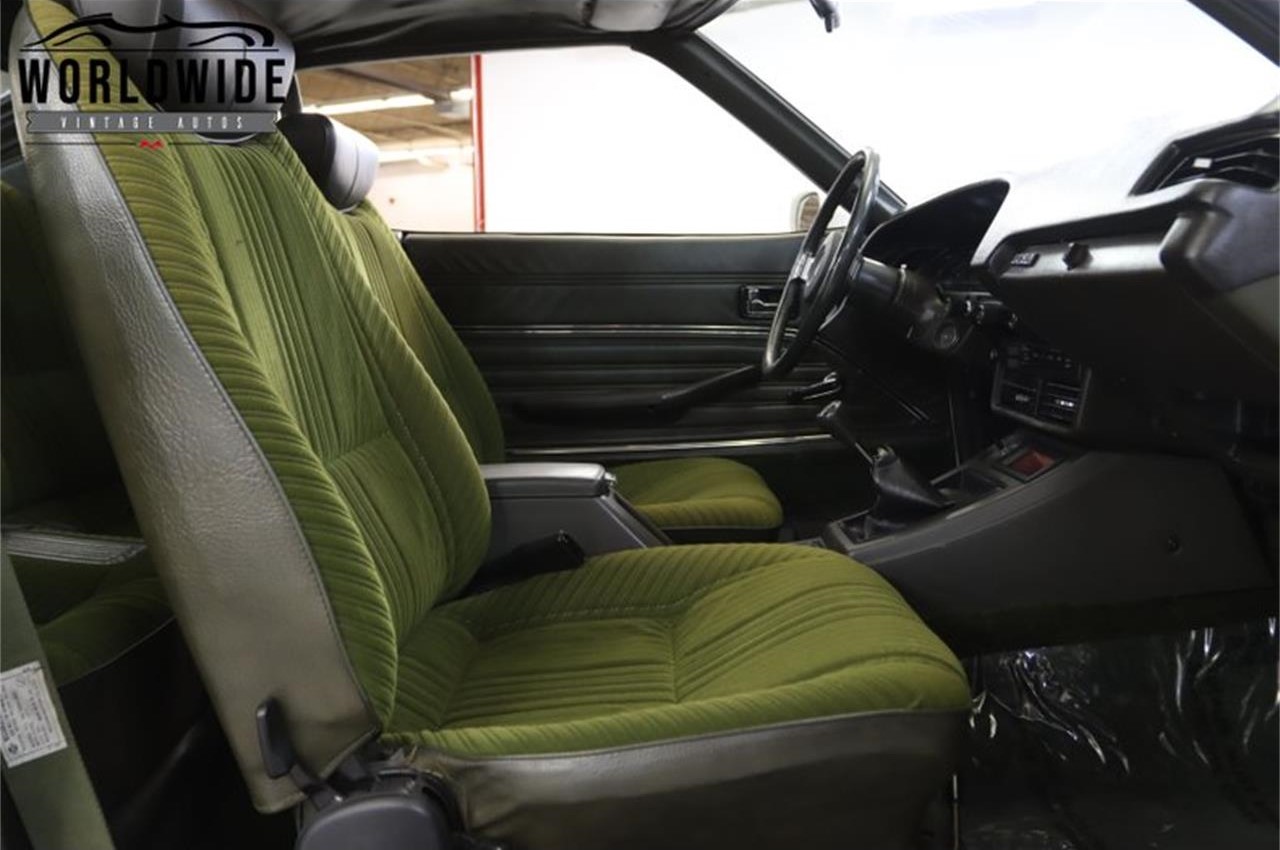
The inside of the 200-SX was a little bit much less “it came from Japan” than the exterior, featuring an inviting wrap-around instrument cluster that appeared more GT than a vehicle based upon the Datsun B210. With the 1979 redesign, the 200-SX moved one action closer to a Japanese-style Camaro as it made with the 1984 redesign. The 200-SX would continue as an absolutely sporty sister to the Z-car via 1999 when it was stopped for the American market, though it proceeded elsewhere through 2002.
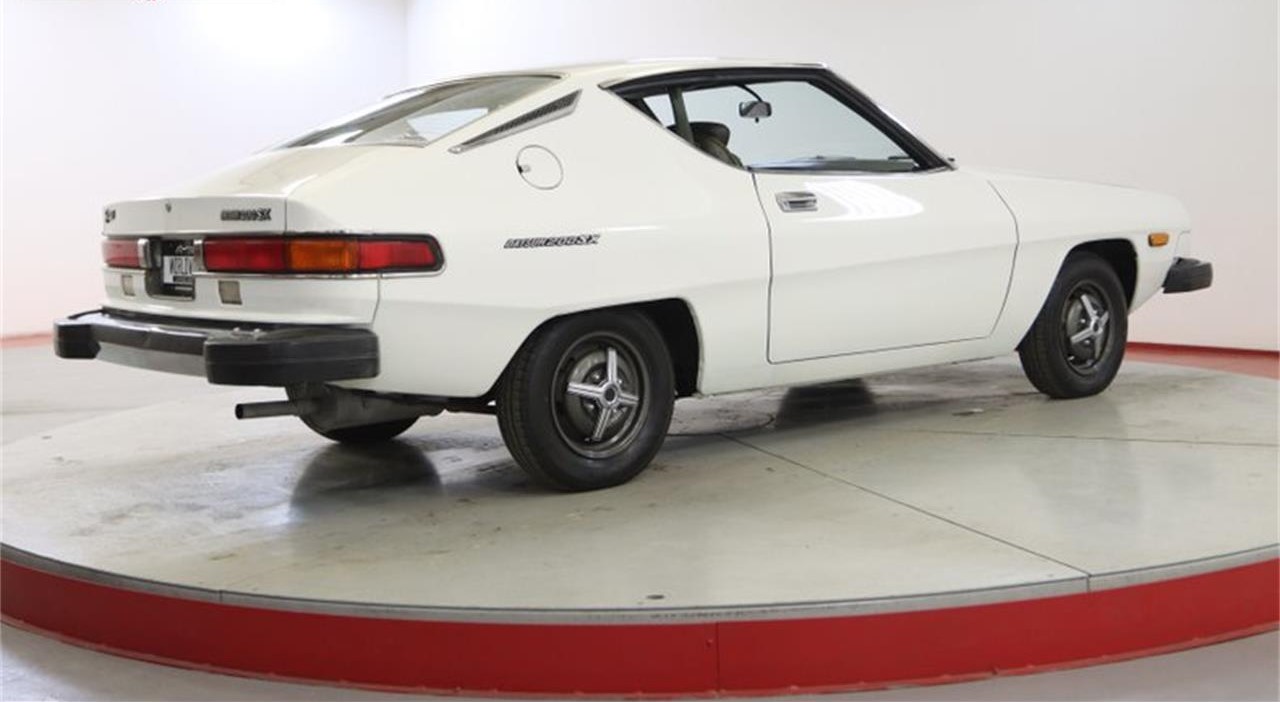
The expense of entry for this Japanese relic? $17,900.
To watch this listing on ClassicCars.com, see Pick of the Day.
For GREAT deals on a new or used INFINITI check out INFINITI of Tucson TODAY!

The National Transportation Safety Board has a simple request: Cars need to slow down to save lives, possibly via technology if the dumb humans behind the wheel refuse to do it. While it sounds like a potential nightmare scenario but let’s take a look at the facts.
NTSB points out that over 108,000 Americans have lost their lives in crashes where speed was a factor over the last decade. Such deaths might be prevented by limiting the speed cars can travel in certain areas. Limiting speed is just the latest recommendation from the federal agency, and has been surprisingly and completely dishonestly reported in a video CNN entitled “Will Tech Force Cars To Slow Down.” The host kicks off the segment by asking “are we getting closer to having our cars monitored and controlled by the government?”
Will Tech Force Cars To Slow Down? | October 11, 2022
Listen, I get it: Who doesn’t like a snappy headline that clicks well? A premise that will get folks active in the comments and lead them to hitting those all-important like and subscribe buttons. But what NTSB actually did was recommend a timetable to put together incentives for automakers that put speed limiters in new cars. Not sure how you get from that to “Our cars are in danger of being monitored and controlled by the government!” Even CNN admits, this “limitation” could come in the form of an audible or visual warning—a feature already familiar to anyone with a newer vehicle.
Advertisement
A little about the NTSB; it’s a federal organization in charge of investigating transportation crashes, whether those crashes happen on highways, water, pipelines or railroads. Since the organization started its work in 1967 the NTSB has issued over 13,000 recommendations for policy changes that studies show would save more lives. These are recommendations, not requirements, though the NTSB closely follows any policy change in support of their recommendations. NTSB recommended, for instance, that all cars come with breathalyzer ignition interlock devices to prevent drunk driving—a requirement also listed in the $1 trillion infrastructure bill. The agency is recommending a three year time frame for coming up with incentives for automakers—not demanding the feds all rig vehicles with government control devices.
The more extreme version of NTSB’s recommendation would involve automakers limiting speeds on their cars using cameras and satellite navigation to control how fast the car is allow to drive. Called Intelligent Speed Assistance, it’s not as dystopian as it sounds; automakers are already required to sell cars with ISA installed in Europe starting this year. Several American automakers, like Ford and Jeep, got a head-start and have been installing the tech in European models for years. A new pilot program in New York City put ISAs in 50 government fleet vehicles — the first city in the nation to do so.
Advertisement
Here’s how it works, from Autocar:
According to the European Transport Safety Council (ETSC), which advised the European Parliament on ISA systems, speeding is a major problem in many European countries, with a large proportion of the 500 deaths each week on EU roads caused by drivers going too fast. Research in Sweden and the Netherlands has shown that when using an ISA system, motorists drive more slowly, even when it can be switched off.
[…]
The system that will become mandatory on new cars in 2022 uses a forward-facing camera mounted on the car and the vehicle’s satellite navigation system to identify the speed limit and, if the car is exceeding it, to restrict the fuel flowing to the engine until the vehicle is at the limit speed.
At no point does it operate the brakes, so the reduction in the car’s speed is gentle and progressive. As the ISA comes into play, the accelerator pedal becomes unresponsive. The ISA system approved by the EU will be overridable, which means the driver can ignore it by firmly pressing the accelerator. If the driver continues to drive above the speed limit, the system will sound and display a warning for several seconds.
The system is likely to be ‘default on’ – meaning it’s active every time the car is started – but can cancelled by the driver at any time. The ETSC recommended this feature be included during the first few years to make ISA systems more acceptable to motorists. Of course, this means the system could one day be permanently active.
Advertisement
The ISA in New York’s cars can be overridden for 15 seconds at the push of a button, and the European drivers can completely turn their ISA off, though studies show the slower driving habit remains even with the ISA turned off.
At no point is the government tracking or controlling anyone’s car, I mean, anymore than they already are. The feds have been controlling your actions on the roads since the first mass-produced cars hit the market and regulating them since the 1960s. If you want to talk about the government tracking American’s movements, consider the license plate readers and automatic cameras already in use by police departments as well as available to civilians, or pedestrian cameras operated by private companies contracted by municipalities. Laws controlling how long such data is stored, who can access it and how it can be use are flimsy at best, or completely nonexistent at worse.
Advertisement
Also, considering the amount of death on American roadways—43,000 people last year alone, a 16-year high—you’d think making cars slow down wouldn’t be the worst idea anyone has ever come up with. We are in no danger of this technology becoming commonplace for many years if ever, despite it being capable of saving thousands of lives every year at the expense of only inconveniencing law-breaking drivers.
If the thought of ISAs controlling your speed makes you uncomfortable, I’ve got bad news for you when it comes to self-driving cars: They will never work until everything—cars, infrastructure, and everyone else—is on a massive, federally built network together. The days of Tesla Autopilot breaking traffic laws are coming to a close. A driverless future won’t happen unless all vehicles obey the rules.
For GREAT deals on a new or used Land Rover check out Land Rover Ventura TODAY!
Experienced by Kimatni Rawlins, www.AutomotiveRhythms.com Welcome to A-Town with cultural influencer as well as social advocate Fly Guy DC of Streetz 94.5 to explore the different levels of the broadcast specialist’s success. He gave Automotive Rhythms thorough understanding into his way of living of home entertainment, songs, sporting activities, as well as style while profiling Atlanta landmarks from the cabin of the brand new, next-level 2022 Lexus NX 350 F Sport. Let’s ride.
We connected with Fly Guy DC while he was concluding Streetz 94.5 on-air tasks prior to striking the city streets of Atlanta to discover the society. Deeply rooted in every little thing astonishing, from sneakers and also style to hip jump artists passing through community, the radio as well as TV individuality was fascinated with the Redline Lexus when we handed him the keys for the vibrant weekend. Most recognized for his ATL night life group control and primetime duty as an on-air radio character, Fly Guy DC has actually recorded the society with his charismatic energy, fast wit, and capitivating professionalism and trust. Furthermore, his holding abilities have actually astounded crowds of over 50,000 guests, consisting of neighborhood efforts, arena events, college homecomings, and also Fortune 500 exhibitions. Fly Guy DC continues to increase his repertoire on different networks including BET, MTV, VH1, Nickelodeon, and REVOLT TELEVISION.
In Georgia’s active as well as expansive city, you can see a variety of container list destinations. A few locations include SkyView Atlanta (a 20-story Ferris wheel in Centennial Park); historic Piedmont Park which inspires much healthier lifestyles; the Tabernacle concert hall, originally opened in 1911; Tyler Perry Studios; the Martin Luther King Jr. National Historical Park, Atlanta’s leading visitor destination; the house of the Atlanta Falcons; as well as Brave’s Stadium to enjoy Ronald Acuna Junior hit homers out of the park.
Fly Guy DC prides himself on favorably affecting our young people, returning to neighborhoods, and also boosting the life experiences of his mentees
. He continuously remains active by taking part in proficiency programs and also occupation days. So naturally, auto security is important. The NX features LSS+3.0, also known as Lexus Safety System Plus, one of the most sophisticated version of LSS and among, otherwise the most innovative suite of conventional safety features in its class. It includes a brand-new E-Latch as well as Safe Exit Assist, which makes use of unseen area monitors to avoid occupants from opening up a door if the lorry finds one more car coming close to also close.
For GREAT deals on a new or used Nissan check out Antelope Valley Nissan TODAY!
Tesla is beginning manufacturing of its electrical Semi, as well as the first of them will be provided to Pepsi starting December 1, Tesla CEO Elon Musk revealed Thursday through Twitter.
It’s been a long roadway to production for the task, which was disclosed in 2017, with the firm after that saying the Semi would certainly enter into production in 2019.
Excited to introduce start of manufacturing of Tesla Semi Truck with distribution to @Pepsi on Dec 1st! pic.twitter.com/gq0l73iGRW
— Elon Musk (@elonmusk) October 6, 2022
That claimed, it’s quicker than Musk had led shareholders to think earlier this year. As just recently as January, Musk had stated that the wait for the Cybertruck, Roadster, and Semi would stretch to 2023, as the firm pushed new products off and also focused this year on scaling output of its existing products, as well as dealing with supply-chain hold-ups and chip scarcities.
Not the very first, yet a huge effectiveness benefit?
Taking into consideration the hold-ups, Tesla isn’t the very first with a Class 8 electrical semi. One of the various other rivals, Freightliner, revealed its first pre-production eCascadia designs in 2019, and placed the trucks to utilize with customers, building up more than a million real-world miles as of 2021. The eCascadia entered normal series manufacturing in May.
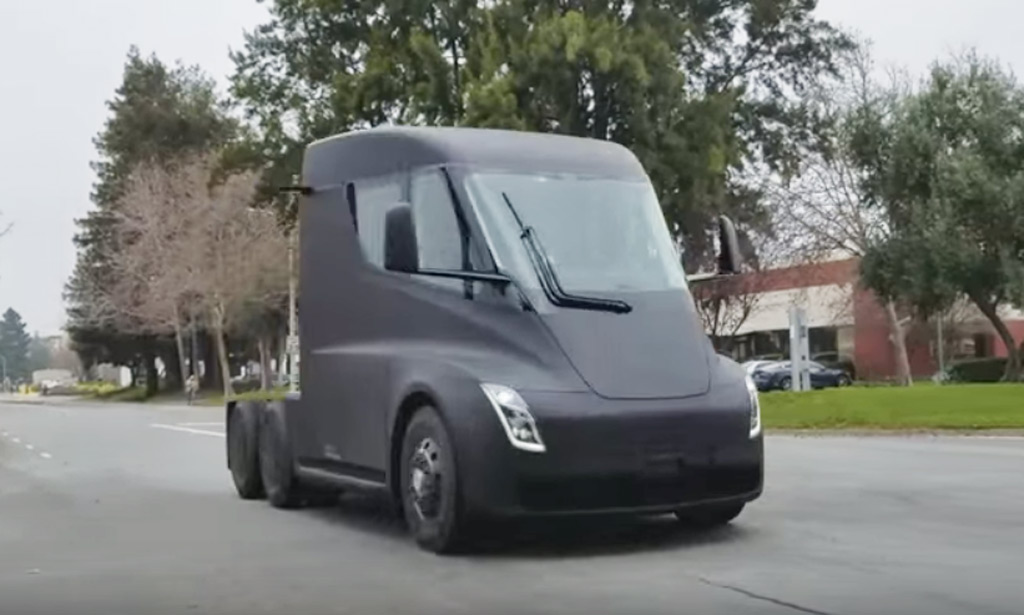
Prototype for Tesla Semi electrical semi-trailer vehicle Musk insisted in a follow-up tweet that the Semi would have a 500-mile variety and be” very fun to drive.”The variety would be a big benefit over the eCascadia’s 230 miles, with its 438-kwh battery pack, if it shows true– and also there stay doubters. Final specs of the Semi haven’t been posted. In August Musk suggested Semis would begin shipping by the end of the year, yet if there’s been a Tesla job with more sliding timelines than even followers can stay up to date with, this has
been it. It’s been about
batteries The reasons Musk has been most vocal about connect to batteries. At numerous points, Musk has actually clarified that the Semi’s production ramp-up was being delayed partially or completely due to the fact that it depended upon numerous cells, The Semi calls for regarding five times as many cells as for a cars and truck.

Cylindrical cells- Panasonic hinting at 4680 progress Musk additionally grumbled in July 2021 that the business’s”Baskin-Robbins of batteries”– read: way too many kinds– scenario needed to be remedied. Eventually it was an all-of-the-above method that helped the business gain enough batteries– consisting of the business’s very own ramp of its 4680 cell layout, the continued usage of the 2170 style for numerous lorries, and its change to LFP cells for some designs.
After that, in September, Tesla’s VP of capitalist relationships Martin Viecha suggested, at a Goldman Sachs presentation, that cell supply was no longer such a problem.

Tesla Supercharger terminal V3, Las Vegas With Semis quickly appearing in some very visible fleets, exactly how will they obtain fees for quick turn-around? Basically, do not seek large Megacharger vehicle quits all set to
offer Tesla Semis, as its Supercharger stations do for its EVs. Do not look for Megachargers at Supercharger terminals either. Tesla Megachargers’minute has actually passed According to Tesla senior charging plan supervisor Francesca Wahl, reacting in a Q&A this past week at the CharIn North America Conference in Portland, attended by Green Car Reports, it’s not mosting likely to happen– at least not anytime soon.
“We don’t necessarily imagine ourselves as a public– also heavy-duty– fast-charging owner-operator, possibly, unless it’s for our very own fleet,” claimed Wahl, replying to a concern about exactly how Tesla intends to participate in megawatt-level charging.
“So similar to others, at first, probably there will certainly be a lot of depot charging, after that there will certainly be public charging,” Wahl added. “And so I think we are really interested to see who will certainly play that duty, how the federal financing will play into that as well as offer the assistance too; yet I don’t assume you’ll be seeing Supercharger websites as heavy-duty websites anytime quickly.”
The 1.5-megawatt Tesla Megacharger concept, which was basically turned out with the Semi prototype, has already been mounted in examination units at its Nevada Gigafactory, at Frito-Lay headquarters, as well as possibly at other customer facilities.
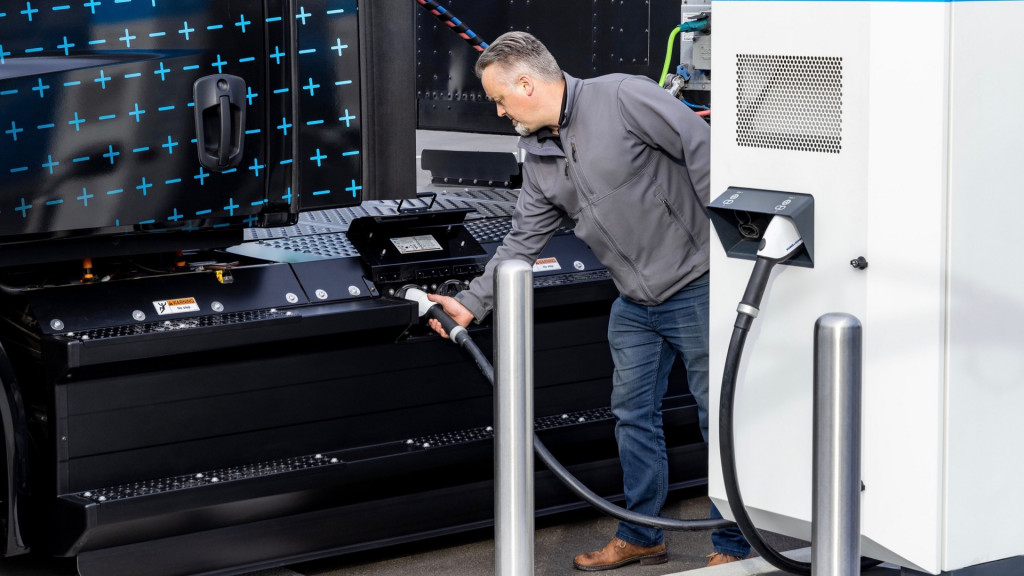
Freightliner eCascadia It may not get a lot better than this. Tesla isn’t exclusive with its charging format in Europe. There, where the billing facilities was currently well built-out by the time of its market access, its automobiles make use of the CCS style. And with the extra obstacles of siting as well as developing a megawatt terminal– plus the opportunity of public cash that will specify format-agnostic– there are motivations to select the virtually fully baked Megawatt Charging Standard, or MCS, that the CharIn seminar concentrated on.
Tesla recommended in 2020 that it’s looking to deploy facilities with other parties, and settle on a common effective sufficient to charge a truck during mandated breaks. And also with the automaker’s ongoing engagement in the advancement of the Megawatt Charging Standard, or MCS, that’s effectively it. As opposed to the choke in between several billing standards, the rare as well as expensive facilities around future megawatt vehicle stops will ideally be deployed for the reduced air pollution and carbon exhausts of all those wanting to deliver goods around, not just those who select a solitary brand name.
For GREAT deals on a new or used Toyota check out Toyota of Orange TODAY!
The Washington State Department of Natural Resources has actually objected to Elon Musk’s recent claim that the Tesla Cybertruck will be waterproof and function as a boat.
On September 29, Musk made the strong insurance claim that the “Cybertruck will certainly be water-proof enough to offer briefly as a boat, so it can go across rivers, lakes & & also seas that aren’t also choppy.”
Check out Also: Elon Musk Says The Tesla Cybertruck Will Be Waterproof And “Serve As A Boat”
The Washington State Department of Natural Resources quickly reacted to this tweet, keeping in mind that its “run-down vessel teams are begging for you to comprehend that anything that ‘serves briefly as a watercraft’ ought to not be utilized as a boat.” They have a factor.
Our derelict vessel crews are asking you to recognize that anything that “serves briefly as a watercraft” ought to not be utilized as a watercraft https://t.co/lcrunbf1DJ pic.twitter.com/j2eL5tGcJZ
— Washington State Dept. of Natural Resources (@waDNR) September 29, 2022
While it is possible that Musk was joking when he stated the Cybertruck can operate as a boat, it seems entirely most likely that he was being major. To us, making such a declaration appears practically unpreventable to lead to suits against Tesla when Cybertruck proprietors take shipment of their EVs, effort to cross a body of water in it, and quickly discover that if you desire a boat, you ought to most likely get a watercraft, not a vehicle that “serves briefly as a boat.”
Musk making such a statement will certainly also put pressure on Tesla to make certain that the Cybertruck can without a doubt make water crossings, as if developing a cutting-edge electrical pickup and selling numerous them had not currently place adequate stress on the cars and truck producer. If the Cybertruck’s launch date is postponed yet again, do not be stunned if Musk takes to Twitter stating it is because of the troubles in getting the vehicle watertight as well as securely drifting.
